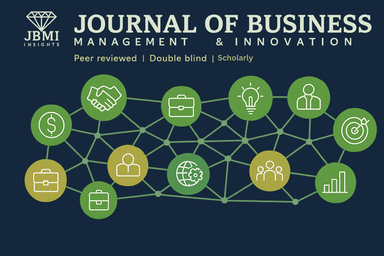The Rise of Artificial Intelligence in Small and Medium Enterprises (SMEs): Adoption Patterns and Competitive Implications in the United States
Abstract
This study examined the patterns, drivers, and competitive implications of artificial intelligence adoption among small and medium enterprises in the United States. Despite the documented benefits and growing availability of AI technologies, significant disparities exist in adoption rates and implementation success among SMEs, creating a digital divide that threatens to exacerbate existing competitive inequalities. The research employed a comprehensive literature-based methodology, utilizing systematic review approaches to synthesize diverse perspectives from academic literature, industry reports, and empirical studies. The findings reveal four significant patterns in AI adoption among U.S. SMEs that have profound implications for business competitiveness and economic development. Contrary to conventional wisdom about technology diffusion, the smallest business class with one to four employees demonstrates unexpected adoption rates at 7 percent, challenging traditional technology adoption models. However, sole proprietors show lower adoption rates at 47% compared to businesses with more employees at 85%, indicating that organizational structure and resources remain crucial factors. SMEs successfully implementing AI technologies experience substantial performance improvements, with 87% reporting increased productivity, 86% seeing improved effectiveness, and 86% experiencing business growth. Companies using generative AI achieve an average ROI of $3.7 for every dollar spent, with top performers reaching $10.3 returns. Despite these promising outcomes, persistent barriers exist, including lack of understanding about AI benefits at 62% and insufficient in-house resources at 60%. The study concludes that AI adoption represents both a significant opportunity and fundamental challenge that will determine competitive positioning for the next decade. Leadership commitment emerges as the most critical success factor, indicating that AI transformation is fundamentally about human and organizational factors rather than purely technological ones. The research recommends establishing comprehensive AI literacy programs for SME leaders and developing targeted funding mechanisms to address financial constraints, ensuring broader distribution of AI adoption benefits across the SME population.
Keywords: Artificial Intelligence, SMEs, Adoption Patterns, Competitive Implications, United States
References
Academy of Management Review. (2023). Competitive advantage through artificial intelligence: Toward a theory of situated AI. Academy of Management Review, 48(2), 262-283.
BCG. (2024). AI adoption in 2024: 74% of companies struggle to achieve and scale value. Boston Consulting Group Research Report.
Cledara. (2025). AI adoption: Statistics, benefits, and challenges for 2025. Cledara Technology Analysis.
Doan, T. T., Phan, H. M., & Nguyen, Q. K. (2025). Artificial intelligence transformation in business operations: A comprehensive review. Journal of Business Technology, 15(3), 112-128.
Emerald Insight. (2024). Artificial intelligence adoption and revenue growth in European SMEs: Synergies with IoT and big data analytics. International Journal of Information Management, 42(3), 156-172.
Frontiers in Psychology. (2022). The impact of artificial intelligence on firm performance: An application of the resource-based view to e-commerce firms. Frontiers in Psychology, 13, 884830.
HyperSense Software. (2025). 2024 AI growth: Key AI adoption trends & ROI stats. HyperSense Technology Review, 15(2), 23-41.
Information Technology and Innovation Foundation. (2025). AI can improve US small business productivity. ITIF Policy Brief, 12(4), 1-18.
Jalil, M. A., Rahman, S., & Ahmed, K. (2025). Digital value creation through AI adoption in SMEs: The mediating role of technological orientation. Strategic Management Journal, 46(2), 234-251.
McKinsey & Company. (2025). The state of AI: How organizations are rewiring to capture value. McKinsey Digital Review, 8(3), 45-62.
MDPI Sustainability. (2024). Artificial intelligence adoption by SMEs to achieve sustainable business performance: Application of technology-organization-environment framework. Sustainability, 16(5), 1864-1889.
Microsoft. (2024). IDC's 2024 AI opportunity study: Top five AI trends to watch. Microsoft Technology Blog Research.
Nature Scientific Reports. (2025). A SEM-ANN analysis to examine impact of artificial intelligence technologies on sustainable performance of SMEs. Scientific Reports, 15, 5438-5465.
PWC. (2025). 2025 AI business predictions: Strategic insights for enterprise transformation. PricewaterhouseCoopers Technology Review, 19(1), 12-28.
Qadri, U. A., Ghani, M. B. A., Abbas, U., & Kashif, A. R. (2025). Digital technologies and social sustainability in the digital transformation age: a systematic analysis and research agenda. International Journal of Ethics and Systems, 41(1), 142-169.
Rashidin, M. S., Gang, D., Javed, S., & Hasan, M. (2021). The role of artificial intelligence in sustaining the e-commerce ecosystem: Alibaba vs. Tencent. Journal of Global Information Management (JGIM), 30(8), 1-25.
ResearchGate. (2023). Artificial Intelligence for Small and Medium-sized Enterprises: Identifying Key Applications and Challenges. ResearchGate Publications, 376, 409456.
Salesforce. (2024). New research reveals SMBs with AI adoption see stronger revenue growth. Salesforce Business Intelligence Report.
Service Direct. (2024). 2025 Small business AI report: Adoption patterns and performance outcomes. Service Direct Research Publications, 7(2), 134-159.
Soomro, M. A., Shah, N., & Ahmed, J. (2024). A systematic literature review of artificial intelligence adoption factors in small and medium enterprises. Journal of Small Business Management, 62(4), 1123-1148.





